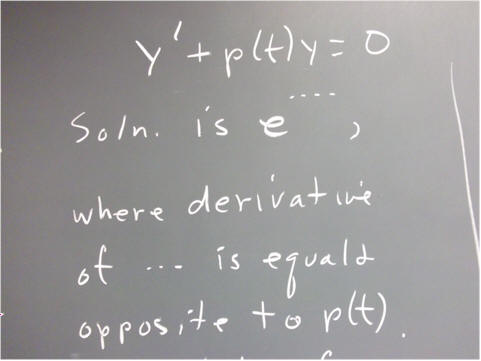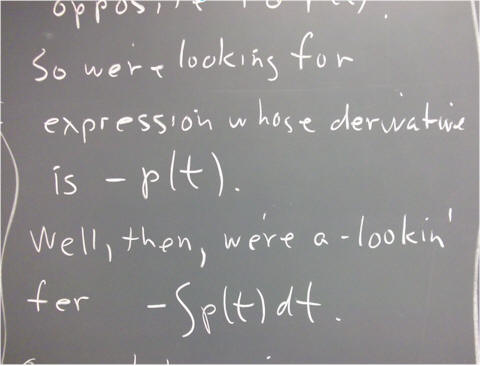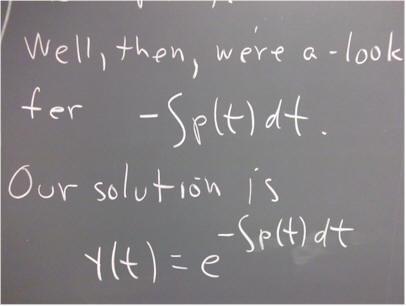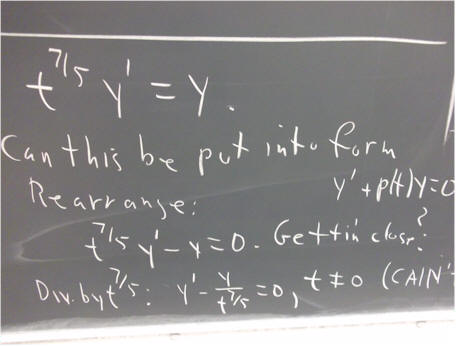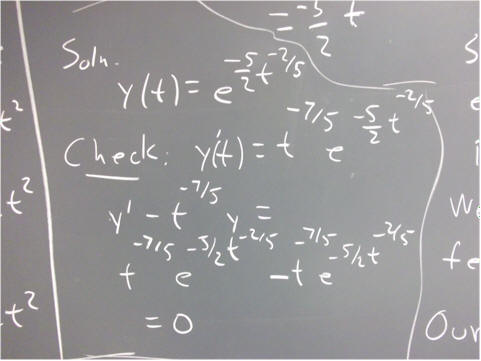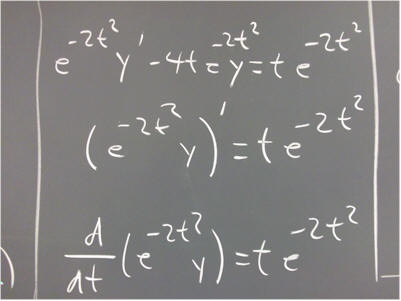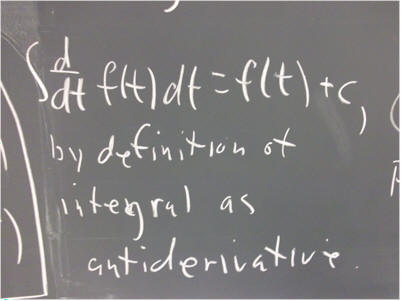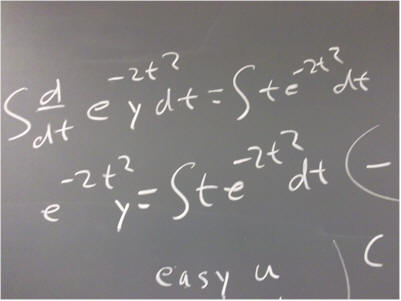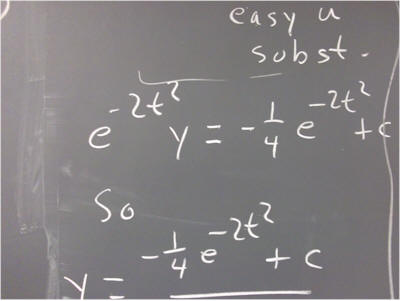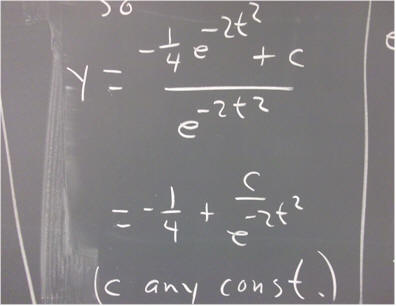
Class Notes 1/24/11 Class.
Note: Do not submit this document. The q_a_ for this assignment contains the same questions, but is formatted slightly differently to make it viewable by the program I use to review documents. When you insert your answers to questions prior to submitting the document, use the q_a_ version, just a click or two away on your Assignments Page.
This document and the next are supplemented by Chapter 2 of the text.
We show the following:
If y = e^(-t) then y ' = -t e^(-t) so that
y ' + t y becomes -t e^-t + t e^-t, which is zero.
If y = e^(cos t) then y ' = -sin(t) e^(cos(t)) so that
y ' + t y becomes -sin(t) e^(cos(t)) + sin(t) e^cos(t) = 0
This is left to you.
Some of this is left to you.
However for one thing, note that they all involve the fact that the derivative of a function of form e^(-p(t)) is equal to -p'(t) e^(-p(t)).
And all of these equations are of the form y ' + p(t) y = 0.
Now you are asked to explain the connection.
What would be a solution to each of the following:
If we integrate sqrt(t) we get 2/3 t^(3/2).
The derivative of e^( 2/3 t^(3/2) ) is t^(1/2) e^ ( 2/3 t^(3/2) ), or sqrt(t) e^( 2/3 t^(3/2) ).
Now, if we substitute y = sqrt(t) e^( 2/3 t^(3/2) ) into the equation, do we get a solution? If not, how can we modify our y function to obtain a solution?
The rest of our equations started with y ' . This one starts with sqrt(t) y '.
We can make it like the others if we divide both sides by sqrt(t).
We get y ' + 1/sqrt(t) * y = 0.
Follow the process we used before.
We first integrated something. What was it we integrated?
We then formed an exponential function, based on our integral. That was our y function. What y function do we get if we imitate the previous problem?
What do we get if we plug our y function into the equation? Do we get a solution? If not, how can we modify our y function to obtain a solution?
If we divide both sides by t and subtract the right-hand side from both sides what equation do we get?
Why would we want to have done this?
Imitating the reasoning we have seen, what is our y function?
Does it work?
This says that you integrate the p(t) function and use it to form your solution y = e^(- int(p(t) dt)).
Does this encapsulate the method we have been using?
Will it always work?
What do you get if you plug y = e^(-int(p(t) dt) into the equation y ' + p(t) y = 0?
Is the equation satisfied?
y ' + p(t) y = 0 is the general form of what we call a first-order linear homogeneous equation. If it can be put into this form, then it is a first-order linear homogeneous equation.
Which of the following is a homogeneous first-order linear equation?
We need y ' to have coefficient 1. We get that if we divide both sides by y.
Having done this, is our equation in the form y ' + p(t) y = 0?
Is our equation therefore a homogeneous first-order linear equation?
Once more, we need y ' to have coefficient t.
What is your conclusion?
Again you need y ' to have coefficient 1.
Then you need the right-hand side to be 0.
Put the equation into this form, then see what you think.
What do you think?
How about this one?
Solve the problems above that are homogeneous first-order linear equations.
Verify the following:
The derivative with respect to t of e^(t^2 / 2) * y is easily found by the product rule to be
(e^(t^2 / 2) * y) '
= (e ^ (t^2 / 2) ) ' y + e^(t^2/2) * y '
= t e^(t^2/2) * y + e^(t^2 / 2) * y '.
If you multiply the expression y ' + t y by e^(t^2 / 2) you get e^(t^2 / 2) y ' + t e^(t^2 / 2).
Same thing.
Now, what is it in the original expression y ' + t y that led us to come up with t^2 / 2 to put into that exponent?
Just do what it says. Find the t derivative of e^(sin(t) ) * y. Then multiply both sides of the expression y ' + cos(t) y by e^(sin(t) * y).
How did we get e^(sin(t)) out of the expression y ' + cos(t)? Where did that sin(t) come from?
You should have the pattern by now. What do you get, and how do we get t^2 / 2 from the expression y ' + t y = t in the first place?
The equation becomes e^(t^2 / 2) * y ' + t e^(t^2 / 2) y = t e^(t^2 / 2).
The left-hand side, as we can easily see, is the derivative with respect to t of e^(t^2 / 2) * y.
So if we integrate the left-hand side with respect to t, since the left-hand side is the derivative of e^(t^2 / 2) * y, an antiderivative is e^(t^2 / 2) * y.
Explain why it's so.
Having integrated the left-hand side, we integrate the right-hand side t e^(t^2 / 2).
What do you get? Be sure to include an integration constant.
Set the results of the two integrations equal and solve for y. What is your result?
Is it a solution to the original equation?
See if you can do this.

